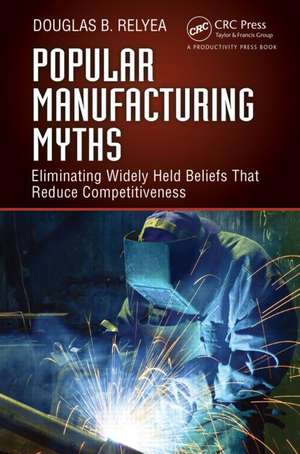Popular Manufacturing Myths: Eliminating Widely Held Beliefs That Reduce Competitiveness
Autor Douglas B. Relyeaen Limba Engleză Hardback – 18 apr 2013
Explaining the reasons why these deeply ingrained beliefs exist, the book outlines remedies that can help to quickly dispel them within your organization. It presents case studies that examine these myths and includes numerous real-world examples that outline simple, yet effective, solutions. Some of the myths dispelled in this book include:
- Increasing line speed always decreases quality and creates more scrap
- Reducing the cost of raw materials will decrease the cost of manufacturing
- Increased inspection will boost quality
- If it is successful in R&D, it will be successful in production
- Process problems can only be solved by changing one process parameter at a time
Preț: 233.06 lei
Preț vechi: 280.32 lei
-17% Nou
Puncte Express: 350
Preț estimativ în valută:
44.60€ • 46.28$ • 37.28£
44.60€ • 46.28$ • 37.28£
Comandă specială
Livrare economică 24 februarie-10 martie
Doresc să fiu notificat când acest titlu va fi disponibil:
Se trimite...
Preluare comenzi: 021 569.72.76
Specificații
ISBN-13: 9781466566606
ISBN-10: 1466566604
Pagini: 135
Ilustrații: 25 b/w images and 9 tables
Dimensiuni: 156 x 234 x 15 mm
Greutate: 0.36 kg
Ediția:New.
Editura: Taylor & Francis
Colecția Productivity Press
Locul publicării:Oxford, United Kingdom
ISBN-10: 1466566604
Pagini: 135
Ilustrații: 25 b/w images and 9 tables
Dimensiuni: 156 x 234 x 15 mm
Greutate: 0.36 kg
Ediția:New.
Editura: Taylor & Francis
Colecția Productivity Press
Locul publicării:Oxford, United Kingdom
Public țintă
Professional Practice & DevelopmentCuprins
Introduction to Manufacturing Myths. Expectational Myths. Data Myths. Our Process Is Different. Measurement Process Myths. Only Adjust One Process Parameter at a Time. Raw Material Myths. Addendum.
Notă biografică
Douglas B. Relyea is the founder and senior partner of Quality Principle Associates a New England-based consulting firm that specializes in the education and application of data analysis techniques to industrial problem solving.
Mr. Relyea has a degree in manufacturing engineering from Three Rivers Community College in Connecticut and a business degree from Eastern Connecticut State University.
He spent twenty years working at General Dynamics and a division of Rogers Corporation, specializing in extrusion, die stamping, machining and molding processes servicing the automotive and business equipment industries. During his time in industry he filled positions such as first-line supervisor, quality assurance manager, engineering manager, maintenance manager, and sales and marketing product manager. Most recently, Mr. Relyea contributed Chapter 19 of the Wire Association International Wire Handbook. This chapter is entitled "Elements of Statistical Quality Control."
In 1987 he left industry and formed Quality Principle Associates.
Mr. Relyea has a degree in manufacturing engineering from Three Rivers Community College in Connecticut and a business degree from Eastern Connecticut State University.
He spent twenty years working at General Dynamics and a division of Rogers Corporation, specializing in extrusion, die stamping, machining and molding processes servicing the automotive and business equipment industries. During his time in industry he filled positions such as first-line supervisor, quality assurance manager, engineering manager, maintenance manager, and sales and marketing product manager. Most recently, Mr. Relyea contributed Chapter 19 of the Wire Association International Wire Handbook. This chapter is entitled "Elements of Statistical Quality Control."
In 1987 he left industry and formed Quality Principle Associates.
Descriere
This book presents a number of case studies that examine widely held beliefs in the manufacturing industry that have been proven to be groundless. Addressing these beliefs and attitudes that can actually be detrimental to competitiveness, it uses real-world examples to outline simple solutions in each case. Dispelling the myth in question, each chapter supplies specific examples that readers can easily relate to. Among the myths dispelled are that increasing line speed always reduces quality and increases scrap; and that reducing the cost of raw materials will reduce the cost of manufacturing.
